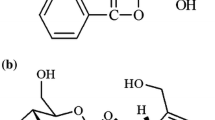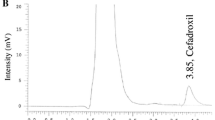Abstract
Pogostemonis herba is used in traditional Chinese medicine to remove dampness, relieve sunstroke, stop vomiting and increase appetite. Patchouli alcohol, an ingredient in pogostemonis herba, has the potential to treat inflammation as well as bacterial and fungal infections. The essential oil of pogostemonis herba (patchouli oil) is commonly given orally in clinical settings; however, no pharmacokinetic studies have examined its oral administration. The goal of this study was to investigate the pharmacokinetic behavior of patchouli alcohol following single-dose oral administration in rats; the influence of other patchouli oil components on the pharmacokinetic profile of patchouli alcohol was also examined. In this study, a simple and selective GC/MS method was developed and validated to measure the level of patchouli alcohol in rat plasma. The study revealed that the pharmacokinetics profile was linear in both the patchouli alcohol and patchouli oil groups. The C max and AUC0–t of patchouli alcohol were greater in all three doses of patchouli alcohol compared to corresponding patchouli oil doses. Additionally, the T max values were significantly greater in the patchouli oil group. These results suggest that the other ingredients in patchouli oil influence the pharmacokinetic behavior of patchouli alcohol during its absorption. The results provide a meaningful basis for evaluating the clinical application of patchouli oil and patchouli alcohol.





Similar content being viewed by others
References
Cai J, Peng C, Wan F, Zen WT, Zhang SW (2013) The mechanism of patchouli oil inhibiting the proliferation and inducing the apoptosis of human prostate cancer cell line PC3. Chin J Androl 11:12–15
Cui HQ (2013) An effective analysis of treating acute gastroenteritis with the Huoxiang Zhengqi pill. Clin J Chin Med 5:87–90
Fan T, Zhang Y, Jiang HL, Min J, Wang K, Zhou W, Mao B, Tang F, Yan FJ, Cai HY, Su XH, Xing XD, Jiang YP, Chen ZB (2012) Huo Xiang Zhengqi dropping pill in treating wind cold and dampness stagnation pattern of common cold: a Randomized Controlled Trial. Chin J Evid Based Med 12:283–288
Hu LF, Li SP, Cao H, Liu JJ, Gao JL, Yang FQ, Wang YT (2006) GC–MS fingerprint of Pogostemon cablin in China. J Pharm Biomed Anal 42:200–206
Ichikawa K, Kinoshita T, Sankawa U (1989) The screening of Chinese crude drugs for Ca2+ antagonist activity: identification of active principles from the aerial part of Pogostemon cablin and the fruits of Prunus mume. Chem Pharm Bull 37:345–348
Jeong JB, Choi J, Lou ZY, Jiang XJ, Lee SH (2013) Patchouli alcohol, an essential oil of Pogostemon cablin, exhibits anti-tumorigenic activity in human colorectal cancer cells. Int Immunopharmacol 16:184–190
Kiuchi F, Matsuo K, Ito M, Qui TK, Honda G (2004) New norditerpenoids with trypanocidal activity from Vitex trifolia. Chem Pharm Bull 52:1495–1496
Lai XP, Su ZR, Zhang FX, Peng SZ, Hu J (2009) Uses of Patchouli alcohol in preparation of medicine. China Patent CN101485647A
Lai XP, Su ZR, Chen JN, Li YC, He JJ (2012) Application of patchouli alcohol in preparation of helicobacter pylori resistant medicament. China Patent CN102349884A
Li YC, Xian YF, Ip SP, Su ZR, Su JY, He JJ, Xie QF, Lai XP, Lin ZX (2011) Anti-inflammatory activity of patchouli alcohol isolated from Pogostemonis Herba in animal models. Fitoterapia 82:1295–1301
Näf F, Decorzant R, Giersch W, Ohloff G (1981) A stereocontrolled access to (±)-, (−)-, and (+)-Patchouli Alcohol. Helv Chim Acta 64:1387–1397
Peng C, Wei XL, Xiong L, Wan F (2012) New application of patchoulic alcohol. China Patent CN102920686A
Peng C, Wei XL, Xiong L, Wan F (2012) Novel application of patchouli alcohol. China Patent CN102895218A
Pohlit AM, Lopes NP, Gama RA, Tadei WP, de Andrade Neto VF (2011) Patent literature on mosquito repellent inventions which contain plant essential oils. A Review. Planta Med 6:598–617
The Pharmacopoeia Commission of PRC (2010) The Pharmacopoeia of the People’s Republic of China, Part 1, Beijing, pp 42–43, 373
Wan AX, Wang SR, Chen Y (2013) Effect of Huoxiang Zhengqi capsules combined with norfloxacin on acute gastroenteritis. Pract Clin Med 14:1–2
Wang DX, Yang Q, Wang CJ, Han YS, Liu QQ (2013) Clinical study on curative effect and safety of Huoxiang Zhengqi dropping pills in treating functional dyspepsia of stagnation of phlegm-damp in middle Jao. Tianjin J Tradit Chin Med 30:593–596
Weide M, Schloesser A, Bockmuehl D, Bolte A, Breves R (2006) Agents against microorganisms containing patchouli oil, patchouli alcohol and/or the derivatives. US Patent 20050303630
Yang Y, Kinoshita K, Koyama K, Takahashi K, Tai T, Nunoura Y, Watanabe K (1999) Anti-emetic principles of Pogostemon cablin (Blanco) Benth. Phytomedicine 6:89–93
Yang DP, Chaumont JP, Millet J (2000) Antifungal activity of the essential oils from Agastache rugosa and Pogostemon cablin against dermatophytes and opportunistic fungi. Chin Pharm J 35:9–11
Yang FC, Xu LZ, Zou ZM, Yang SL (2004) Pharmacokinetics of patchouli alcohol and patchouli alcohol in patchouli oil after iv administrated to rats. Acta Pharm Sin 39:726–729
Yang Q, Wang DX, Liu QQ, Han YS, Wang CJ (2012) Multi-central clinical study of Huoxiang Zhengqi dripping pill on acute gastritis with affection by external pathogenic factors. Tianjin J Tradit Chin Med 29:13–16
You XH, Wang RC, Tang WX, Li Y, He ZJ, Hu HY, Wu CB (2010) Self-microemulsifying drug delivery system of patchoulic alcohol to improve oral bioavailability in rats. China J Chin Mater Med 35:694–698
Zhu BCR, Henderson G, Yu Y, Laine RA (2013) Toxicity and repellency of patchouli oil and patchouli alcohol against Formosan subterranean termites Coptotermes formosanus Shiraki (Isoptera: Rhinotermitidae). J Agric Food Chem 51:4585–4588
Acknowledgments
The authors gratefully acknowledge the assistance of Feng Wan and Doctor Liang Xiong in the extraction of PA and patchouli oil. We thank Associate Professor of Pharmacy Yun-tao Jia and Dr. Lin Song (Department of Pharmacy, Children’s Hospital of Chongqing Medical University, Chongqing 400014, China) for reviewing this article and advices. This study was supported by science and technology support program (No. 2014SZ0071) by Sichuan Province.
Conflict of interest
All the authors have declared no conflict of interest.
Author information
Authors and Affiliations
Corresponding author
Rights and permissions
About this article
Cite this article
Zhang, R., Yan, P., Li, Y. et al. A pharmacokinetic study of patchouli alcohol after a single oral administration of patchouli alcohol or patchouli oil in rats. Eur J Drug Metab Pharmacokinet 41, 441–448 (2016). https://doi.org/10.1007/s13318-015-0272-7
Received:
Accepted:
Published:
Issue Date:
DOI: https://doi.org/10.1007/s13318-015-0272-7




